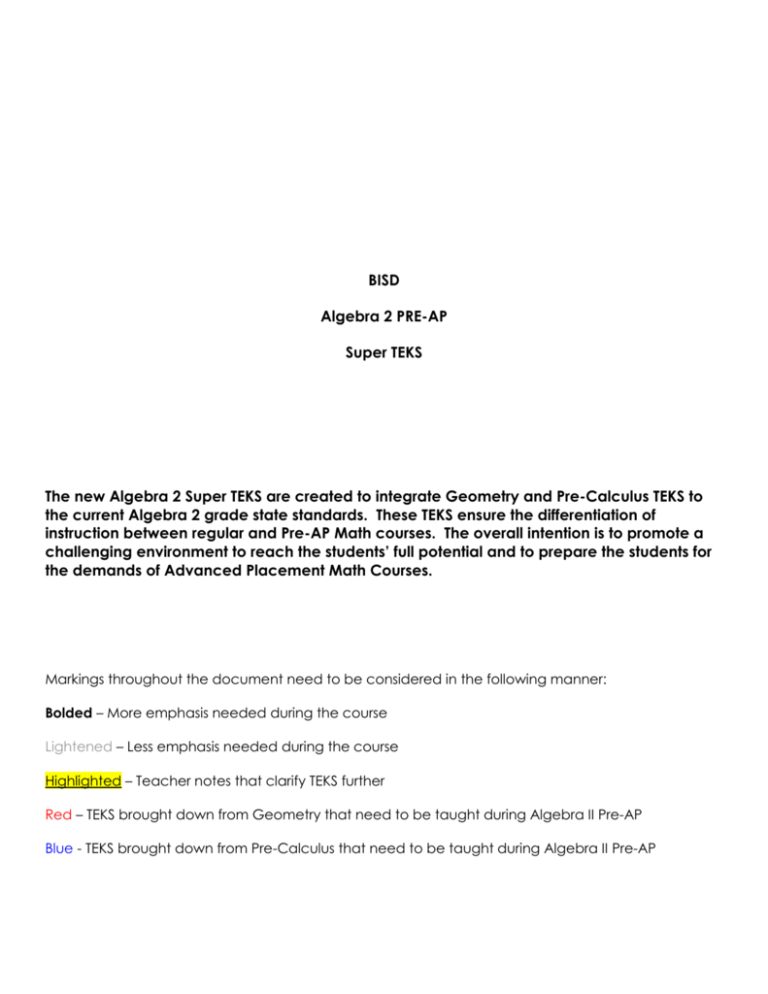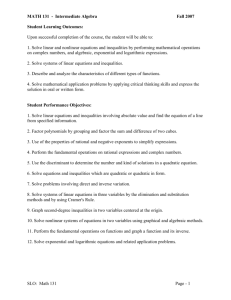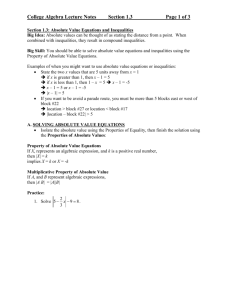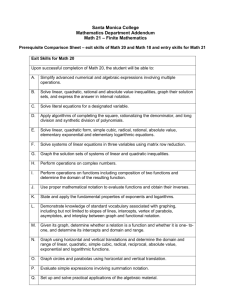Pre-AP Algebra 2 Grade Super TEKS
advertisement

BISD Algebra 2 PRE-AP Super TEKS The new Algebra 2 Super TEKS are created to integrate Geometry and Pre-Calculus TEKS to the current Algebra 2 grade state standards. These TEKS ensure the differentiation of instruction between regular and Pre-AP Math courses. The overall intention is to promote a challenging environment to reach the students’ full potential and to prepare the students for the demands of Advanced Placement Math Courses. Markings throughout the document need to be considered in the following manner: Bolded – More emphasis needed during the course Lightened – Less emphasis needed during the course Highlighted – Teacher notes that clarify TEKS further Red – TEKS brought down from Geometry that need to be taught during Algebra II Pre-AP Blue - TEKS brought down from Pre-Calculus that need to be taught during Algebra II Pre-AP §111.33. Algebra II (One-Half to One Credit). (a) Basic understandings. (1) Foundation concepts for high school mathematics. As presented in Grades K-8, the basic understandings of number, operation, and quantitative reasoning; patterns, relationships, and algebraic thinking; geometry; measurement; and probability and statistics are essential foundations for all work in high school mathematics. Students continue to build on this foundation as they expand their understanding through other mathematical experiences. (2) Algebraic thinking and symbolic reasoning. Symbolic reasoning plays a critical role in algebra; symbols provide powerful ways to represent mathematical situations and to express generalizations. Students study algebraic concepts and the relationships among them to better understand the structure of algebra. (3) Functions, equations, and their relationship. The study of functions, equations, and their relationship is central to all of mathematics. Students perceive functions and equations as means for analyzing and understanding a broad variety of relationships and as a useful tool for expressing generalizations. (4) Relationship between algebra and geometry. Equations and functions are algebraic tools that can be used to represent geometric curves and figures; similarly, geometric figures can illustrate algebraic relationships. Students perceive the connections between algebra and geometry and use the tools of one to help solve problems in the other. (5) Tools for algebraic thinking. Techniques for working with functions and equations are essential in understanding underlying relationships. Students use a variety of representations (concrete, pictorial, numerical, symbolic, graphical, and verbal), tools, and technology (including, but not limited to, calculators with graphing capabilities, data collection devices, and computers) to model mathematical situations to solve meaningful problems. (6) Underlying mathematical processes. Many processes underlie all content areas in mathematics. As they do mathematics, students continually use problem-solving, language and communication, and reasoning (justification and proof) to make connections within and outside mathematics. Students also use multiple representations, technology, applications and modeling, and numerical fluency in problemsolving contexts. (b) Knowledge and skills. (1) Foundations for functions. The student uses properties and attributes of functions and applies functions to problem situations. The student is expected to: (A) identify the mathematical domains and ranges of functions and determine reasonable domain and range values for continuous and discrete situations; and PC (c1B) determine the domain and range of functions using graphs, tables, and symbols; (P.1B) (B) collect and organize data, make and interpret scatter plots, fit the graph of a function to the data, interpret the results, and proceed to model, predict, and make decisions and critical judgments. PC (c3C) use regression to determine the appropriateness of a linear function to model real-life data (including using technology to determine the correlation coefficient); (P.3D) PC (c3D) use properties of functions to analyze and solve problems and make predictions (P.3E) TEACHER NOTE: include polynomial, rational, power (including radical), exponential, logarithmic, and piecewise-defined functions. (2) Foundations for functions. The student understands the importance of the skills required to manipulate symbols in order to solve problems and uses the necessary algebraic skills required to simplify algebraic expressions and solve equations and inequalities in problem situations. The student is expected to: (A) use tools including factoring and properties of exponents to simplify expressions and to transform and solve equations; and (B) use complex numbers to describe the solutions of quadratic equations. PC (c1C) describe symmetry of graphs of even and odd functions; (P.1C) PC (c1D) recognize and use connections among significant values of a function (zeros, maximum values, minimum values, etc.), points on the graph of a function, and the symbolic representation of a function; (P.1D) (3) Foundations for functions. The student formulates systems of equations and inequalities from problem situations, uses a variety of methods to solve them, and analyzes the solutions in terms of the situations. The student is expected to: G (Gb7B) use slopes and equations of lines to investigate geometric relationships, including parallel lines, perpendicular lines, and special segments of triangles and other polygons; TEACHER NOTE: Use “Normal” and “Orthogonal” for perpendicular. And provide examples of lines tangent to curves. G (Gb9A) formulate and test conjectures about the properties of parallel and lines based on explorations and concrete models; perpendicular (A) analyze situations and formulate systems of equations in two or more unknowns or inequalities in two unknowns to solve problems; (B) use algebraic methods, graphs, tables, or matrices, to solve systems of equations or inequalities; and TEACHER NOTE: After algebraically solving inequalities, have students input values less than and greater than the solution into the original inequality, in order to create a number line with increasing and decreasing intervals. (C) interpret and determine the reasonableness of solutions to systems of equations or inequalities for given contexts. (4) Algebra and geometry. The student connects algebraic and geometric representations of functions. The student is expected to: (A) identify and sketch graphs of parent functions, including linear (f (x) = x), quadratic (f (x) = x2), exponential (f (x) = ax), and logarithmic (f (x) = logax) functions, absolute value of x (f (x) = |x|), square root of x (f (x) = x), and reciprocal of x (f (x) = 1/x); (B) extend parent functions with parameters such as a in f (x) = a/x and describe the effects of the parameter changes on the graph of parent functions; and PC (c2A) apply basic transformations, including a • f(x), f(x) + d, f(x - c), f(b • x), and compositions with absolute value functions, including |f(x)|, and f(|x|), to the parent functions; (P.2A) (C) describe and analyze the relationship between a function and its inverse. PC (c2B) perform operations including composition on functions, find inverses, and describe these procedures and results verbally, numerically, symbolically, and graphically; (P.2B) (5) Algebra and geometry. The student knows the relationship between the geometric and algebraic descriptions of conic sections. The student is expected to: G (Gb6A) describe and draw the intersection of a given plane with various three-dimensional geometric figures; (A) describe a conic section as the intersection of a plane and a cone; TEACHER NOTE: Students should visualize the cross-section of 3-dimensional objects. (B) sketch graphs of conic sections to relate simple parameter changes in the equation to corresponding changes in the graph; (C) identify symmetries from graphs of conic sections; (D) identify the conic section from a given equation; and PC (c5A) use conic sections to model motion, such as the graph of velocity vs. position of a pendulum and motions of planets; (P.5A) TEACHER NOTE: emphasize velocity is the rate of change of the position (c5B) use properties of conic sections to describe physical phenomena such as the reflective properties of light and sound; (P.5B) (E) use the method of completing the square. (6) Quadratic and square root functions. The student understands that quadratic functions can be represented in different ways and translates among their various representations. The student is expected to: (A) determine the reasonable domain and range values of quadratic functions, as well as interpret and determine the reasonableness of solutions to quadratic equations and inequalities; (B) relate representations of quadratic functions, such as algebraic, tabular, graphical, and verbal descriptions; and (C) determine a quadratic function from its roots (real and complex) or a graph. (7) Quadratic and square root functions. The student interprets and describes the effects of changes in the parameters of quadratic functions in applied and mathematical situations. The student is expected to: (A) use characteristics of the quadratic parent function to sketch the related graphs and connect between the y = ax2 + bx + c and the y = a (x - h)2 + k symbolic representations of quadratic functions; and (B) use the parent function to investigate, describe, and predict the effects of changes in a, h, and k on the graphs of y = a (x - h)2 + k form of a function in applied and purely mathematical situations. (8) Quadratic and square root functions. The student formulates equations and inequalities based on quadratic functions, uses a variety of methods to solve them, and analyzes the solutions in terms of the situation. The student is expected to: (A) analyze situations involving quadratic functions and formulate quadratic equations or inequalities to solve problems; (B) analyze and interpret the solutions of quadratic equations using discriminants and solve quadratic equations using the quadratic formula; (C) compare and translate between algebraic and graphical solutions of quadratic equations; and (D) solve quadratic equations and inequalities using graphs, tables, and algebraic methods. TEACHER NOTE: have students input values to quadratic functions to determine increasing and decreasing intervals (9) Quadratic and square root functions. The student formulates equations and inequalities based on square root functions, uses a variety of methods to solve them, and analyzes the solutions in terms of the situation. The student is expected to: (A) use the parent function to investigate, describe, and predict the effects of parameter changes on the graphs of square root functions and describe limitations on the domains and ranges; (B) relate representations of square root functions, such as algebraic, tabular, graphical, and verbal descriptions; (C) determine the reasonable domain and range values of square root functions, as well as interpret and determine the reasonableness of solutions to square root equations and inequalities; (D) determine solutions of square root equations using graphs, tables, and algebraic methods; (E) determine solutions of square root inequalities using graphs and tables; (F) analyze situations modeled by square root functions, formulate equations or inequalities, select a method, and solve problems; and (G) connect inverses of square root functions with quadratic functions. (10) Rational functions. The student formulates equations and inequalities based on rational functions, uses a variety of methods to solve them, and analyzes the solutions in terms of the situation. The student is expected to: (A) use quotients of polynomials to describe the graphs of rational functions, predict the effects of parameter changes, describe limitations on the domains and ranges, and examine asymptotic behavior; (B) analyze various representations of rational functions with respect to problem situations; (C) determine the reasonable domain and range values of rational functions, as well as interpret and determine the reasonableness of solutions to rational equations and inequalities; (D) determine the solutions of rational equations using graphs, tables, and algebraic methods; (E) determine solutions of rational inequalities using graphs and tables; (F) analyze a situation modeled by a rational function, formulate an equation or inequality composed of a linear or quadratic function, and solve the problem; and (G) use functions to model and make predictions in problem situations involving direct and inverse variation. (11) Exponential and logarithmic functions. The student formulates equations and inequalities based on exponential and logarithmic functions, uses a variety of methods to solve them, and analyzes the solutions in terms of the situation. The student is expected to: (A) develop the definition of logarithms by exploring and describing the relationship between exponential functions and their inverses; (B) use the parent functions to investigate, describe, and predict the effects of parameter changes on the graphs of exponential and logarithmic functions, describe limitations on the domains and ranges, and examine asymptotic behavior; (C) determine the reasonable domain and range values of exponential and logarithmic functions, as well as interpret and determine the reasonableness of solutions to exponential and logarithmic equations and inequalities; (D) determine solutions of exponential and logarithmic equations using graphs, tables, and algebraic methods; (E) determine solutions of exponential and logarithmic inequalities using graphs and tables; and (F) analyze a situation modeled by an exponential function, formulate an equation or inequality, and solve the problem. PC (c3B) use functions such as logarithmic, exponential, trigonometric, polynomial, etc. to model real-life data; (P.3C) Source: The provisions of this §111.33 adopted to be effective September 1, 1996, 21 TexReg 7371; amended to be effective August 1, 2006, 30 TexReg 1931; amended to be effective February 22, 2009, 34 TexReg 1056.








